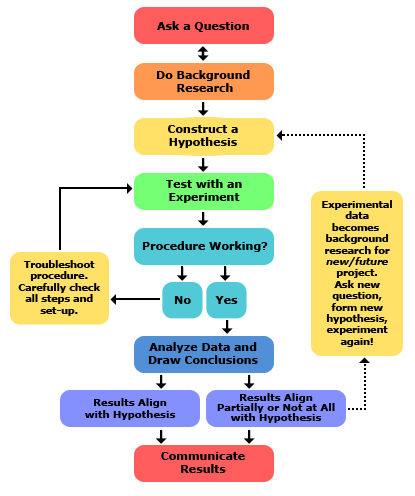The answer turns out to be very simple. The science is in the test. Ideas, opinions, even reason and logic themselves are all ancillary concepts to the test. If it isn't tested (or for whatever reason can't be tested, such as supernatural beliefs), then it isn't science. That isn't to say that it's wrong or bad, simply that it isn't science.
Science is the act of validating something with a test.You can believe whatever you like. You can even apply vast amounts of reason and logic and irrefutably derive a very sensible conclusion about something. But if you don't validate it with a test, it's not science. It's conjecture, speculation. And as I like to say at work, "Speculation is free, and worth every penny."
A Google search on "the scientific method" (which I think we can agree is the core foundation of all scientific study) lands me on a site called Science Buddies, which presents this handy graphic to visualize the process:
This seems similar enough to what I remember from grammar school. Notice a few key points:
- Attention is drawn to the bright green box. (Green means good, right?) That box is the center of the whole process. That box is the test being conducted.
- The very first step is "Ask a Question." Not define what you think the answer is, not speculate on possible outcomes, but simply ask the question.
- There's a cycle to the process, using the tests to validate each iteration of the cycle. The results of the tests are fed back into the process to make further progress.
This reminds me of another cycle of testing:
Even the coloring is the same. The first step, in red, is to ask the question. The central step, in green, is to run a test against the implementation to produce results, validating both the test and the implementation. The loop back step, in blue, is to adjust the system based on the results of the test and return to the start of the cycle, using the test and its results to further refine and grow the next test(s).
TDD is the Scientific Method applied to software development.The two processes share core fundamental values. Values such as:
- Begin by asking a question. The purpose of the process is not to answer the question, but to arrive at a means of validating an answer. Answers can change over time, the key value is in being able to validate those answers.
- Tests must be repeatable. Other team members, other teams, automated systems, etc. must be able to set up and execute the test and observe the results. If the results are inconsistent then the tests themselves are not valid and must be refined, removing variables and dependencies to focus entirely on the subject being tested.
- The process is iterative and cyclic. Value is attained not immediately, but increasingly over time. Validating something once is only the first step in the process, if the same thing can't be validated repeatedly then it wasn't valid in the first place, the initial result was a false positive. Only through repetition and analysis can one truly be confident in the result.
We've all heard the analogy that TDD is similar to double-entry bookkeeping. And that analogy still holds true. This one is just resonating with me a lot more at the moment. It's not just the notion that the code and the tests mutually confirm each other, but that the fundamental notion of being able to validate something with a repeatable test is critical to truly understanding that something. Anything else is just speculation.


No comments:
Post a Comment